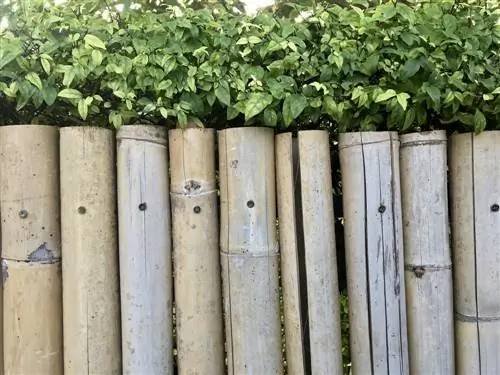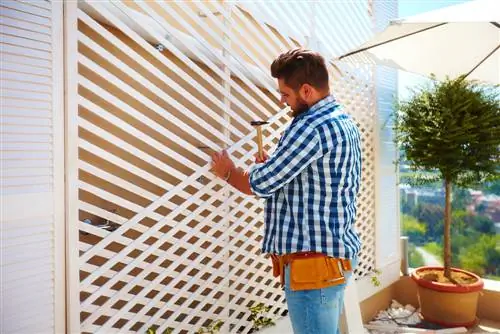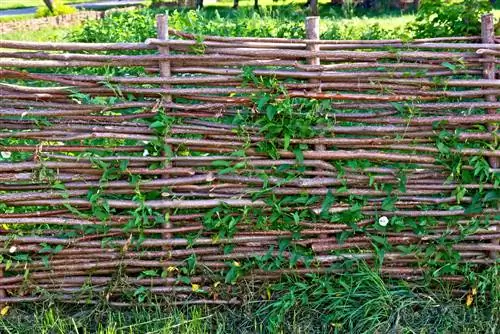- Author admin [email protected].
- Public 2023-12-16 16:46.
- Last modified 2025-06-01 06:02.
Who wants to sunbathe under the prying eyes of their neighbors? With a privacy screen you not only protect your privacy, but are also protected from annoying wind. Prefabricated elements made of wood are practical and cost-effective and can be used to build a stable and decorative privacy screen. This guide explains how to do it correctly.

How do I build a privacy screen in my garden myself?
To build a privacy screen in the garden yourself, you need prefabricated wooden elements, posts, post anchors, fittings and tools. Erect the posts with anchors, attach the fence elements to the fittings and then set the posts in concrete. Protect the wood with a glaze.
Privacy fences are subject to building regulations
Before construction work starts, please contact the local building authority. The creation of fencing is subject to different requirements in the individual federal states. These not only concern the height and the distance to the neighboring property. Some regions require certain materials or a maximum height for a fence.
Material and tool list
Competent providers of fence elements for privacy provide various planning aids to determine the exact number of elements. Since most modules cannot be shortened later, a detailed, true-to-scale sketch is essential. In addition to the fence elements, the following tools and materials are required for construction:
- Spade
- Hammer
- Cordless screwdriver
- Mason's Trowel
- Ratchet
- Plumb bob
- Ruler and pencil
- Mason's line or tape measure
- Spirit level
- Hexagon head screws (M10 x 110 mm)
- Washers and nuts
- Post anchor
- Sticky Notes
- Precast concrete
- Wooden slats
- Wood stain with the Blue Angel
- Brush
If a privacy element is connected to a house wall, you will need additional wall anchors for attaching the corner posts.
Preparation work - how to stay oriented
Mark the exact route of the privacy fence using a tightly stretched mason's line from corner post to corner post of each fence element. If the privacy screen runs over a corner, align the course using a construction angle. Mark the positions of the posts along the stretched cord with sticky notes. If you attach the plumb bob to a sticky note, you will know exactly where to dig the hole for the post anchor.
Inserting posts for fence elements - this is how it works
After you have determined the positions for the corner posts of the fence elements, it is best to dig all the pits in one go. How to do it right:
- Dig 80 cm deep holes with the shovel for a frost-free concrete foundation
- Pre-drill holes in the posts with the cordless screwdriver for the hexagon screws of the post anchors
- Screw the posts and anchors together
- Measure and mark the positions of the fittings on the posts
- Attach fittings to all posts in one go
As a rule, at least 4 fittings are required per post in order to later fix the fence elements to them. To prevent the wood from cracking, please pre-drill each screw hole.
Attach fence elements - you should pay attention to this
To prevent large privacy fence elements from bending, support the lower edges with stacked stones. We recommend a second man as a helping hand during this process. Use wooden wedges to align each module. Proceed as follows:
- Place the pre-assembled posts in the pit and align them straight
- Check the bottom and top of the fence element to ensure that the edge runs in a straight line on the post
- Screw the fence modules with the pre-installed fittings
The challenge in this step is to give the posts that have not yet been set in concrete enough stability that you can screw the fence elements onto them. Stack bricks on two sides of a post. Now push a sturdy wooden slat through the post anchor so that it rests on the surfaces of the stones. If there is still a lack of stability, insert wedges between them on the right and left.
Setting corner posts in concrete - this is how you do it right
Use wooden slats to temporarily support the privacy screen. Only be satisfied with the alignment once the spirit level confirms a vertical adjustment. Now fill ready-made concrete or screed concrete into the post holes. Do this in layers, alternately pouring concrete and water into it. Smooth the surface with the trowel.
Wood stain protects against weather influences
To prevent your new wooden privacy screen from weathering, paint the fence with wood stain in the final step (€22.00 at Amazon). We recommend a product with the Blue Angel. This certificate confirms that there are no harmful ingredients in it, such as plasticizers and similar chemicals.
What to do on sloping terrain?
If you notice during planning and measurements that your garden has a slight slope, you can straighten the area. Use tensioned ropes and a plumb bob to determine the difference in height. You then gradually level this out with topsoil until the spirit level indicates a flat surface.
Sharper slopes require a different approach if you build a privacy screen in the garden yourself. Under these circumstances, a stair-like installation has proven to work well in practice. The posts are shortened to fit precisely at the bottom end. It is important to note that the upper end of a post located downhill is always flush with the fence element facing uphill.
Tip
In the natural garden, privacy protection made of shrubs is very popular. With growth rockets such as privet or cherry laurel, prying eyes over the garden fence will quickly become a thing of the past. You can do this cost-effectively with bare-root products that you plant in the ground at the best planting time in autumn.






